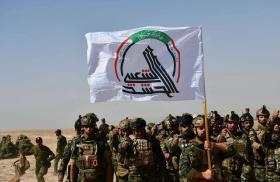Militia List of U.S. “Greatest Hits” Gives Insight Into Attack Cell Structure
A poster of thirty-six militia “martyrs” provides useful data about who was killed by U.S. forces at specific times and places.
On November 6, the Islamic Resistance in Iraq (IRI) War Media released a claim of a Shahed-101 drone attack on Israel, specifying "a military target in Jordan Valley." Instead of the typical imagery shown in these claims—with a drone appearing alongside a very recognizable militia “martyr” such as Hassan Nasrallah or Hashem Safieddine—this drone was shown with a sheet of thirty-six faces belonging to Iraqi “martyrs” whom IRI claims have been killed by U.S. strikes during the Gaza war. If these fighters have indeed been accurately linked to specific strikes (see Figure 1), it provides some interesting potential findings about the Iraqi muqawama (resistance) war effort over the past year.
Finding 1: No militia fighters are claimed to have been killed by the first four of the ten U.S. strikes listed. This is a reminder that the United States "started slow" in its campaign of counterstrikes, initially using nonlethal strikes aimed at buildings and arms caches (on October 27 and 30 and November 9 and 13, 2023). U.S. deterrence became more effective when militia personnel were struck in large numbers, including leaders. (For a full listing of Iraqi militia attacks and U.S. responses, see Militia Spotlight's tracker.)
Finding 2: The United States began killing designated militia leaders on December 26, 2023. The Christmas 2023 strike that grievously wounded an American was met with an angry response on December 26, with a strike that killed just one militiaman, but an important one: Dera Ali al-Ameri, the commander of the Popular Mobilization Forces 47th Brigade, a unit belonging to the U.S.-designated militia Kataib Hezbollah (KH). By linking Dera to the PMF, the November 6 “martyr” statement underlined Iraqi government complicity in attacks on U.S. forces—that is, a senior PMF commander was selected by the United States for lethal targeting due to his involvement in terrorist acts and membership in a terrorist organization.
Finding 3: Many militia “martyrs” are not associated here with specific terrorist organizations. The IRI statement only ascribed factional membership to half of the listed fighters: eleven (30%) to KH and seven (19%) to Harakat Hezbollah al-Nujaba. Most of the remaining men were not tied to any faction, with one exception: the seemingly senior fighter Alaa Abdal-Abadi of the PMF's 33rd Brigade (aka Quwat Waad Allah, a Fadhila Party militia). This opens up many possibilities. Why would militia groups, who are generally proud of their "martyrs," not claim them? It stands to reason that the unclaimed men on the list may be tied to PMF units that are not yet sanctioned by the United States or otherwise deliberately targeted. Nine of the unclaimed were killed during U.S. strikes in Jurf al-Sakhar on November 22, 2023; the other eight were killed during February 3, 2024, strikes in central and western Anbar, which included KH's Jazira Operations Command/PMF Western Anbar Operations Command headquarters in locations such as Akashat and al-Qaim. These sites tend to draw personnel from numerous groups closely associated with KH such as Liwa al-Tafuf (13th PMF Brigade), Ansar Allah al-Awfiya (19th Brigade), Harakat al-Abdal (39th Brigade), Saraya al-Jihad (17th Brigade), and the less capable Liwa al-Muntadher (7th Brigade). One can now add the 33rd Brigade to this list.
Finding 4: Nujaba was not present in Anbar. If the listing is accurate, the only Nujaba deaths are the drone cell destroyed in Dibis, near Kirkuk, on December 3, 2023, and the commander killed in Baghdad on January 4, 2024. This fits neatly with other data points indicating that Nujaba is focused on U.S. targets in Iraqi Kurdistan (from northern launch points) or Syria (from Syrian launch areas). The apparent Nujaba cell leader killed at Dibis, Hussein Hadi al-Aqabi, apparently had close ties to Abu Taqwa, the high-level Nujaba leader killed on January 4 (Figure 2).
Finding 5: No Kataib Sayyid al-Shuhada (KSS) "martyrs" are shown. This may indicate that KSS plays a very small role in kinetic actions, and/or that all of its actions and communications use the Saraya Awliya al-Dam brand, separate from the IRI brand.




